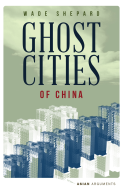Ghost Cities of China

Fittingly for a book written by the editor-in-chief of The China Chronicle, a media website based largely on travel writing, this is a journalistic and personal account of a less analysed phenomenon of Chinese development. The author, Wade Shepard, spent two years exploring new cities that are relatively unknown despite being located in the world’s most populous country. This phenomenon is the ghost city, described as a “side effect” of the rush toward urbanization in China.
Ghost cities are largely unoccupied despite their buildings and infrastructure. They differ from the traditional image of ghost towns as areas that have enjoyed a period of vitality and then been abandoned due to economic, natural or social hardship. Instead, Chinese ghost cities never see life. They might reflect urban development projects that lose funding partway through. Or, as in skyscraper-stuffed Zhengdong, they might be new cities built within existing cities. Here the less crowded, better serviced new city is intended house the wealthy while the old city is home to poorer residents; economic realities mean that the former lies empty while the latter is congested. The great diversity of Chinese cities, including its ghost cities, can be seen in the case studies Shepard describes, from an “ecocity” populated by the rich to a British replica known as Thames Town.
Shepard attributes the rise of ghost cities to several factors. One is the rapid pace of urbanization; in China 600 new cities have been created over 65 years – the fastest pace of development the world has ever seen. This is accompanied by rapid building and rebuilding, with one estimate being that the average building in China will be demolished in 25 to 30 years. Frequent demolition and construction are seen as boons to consumer culture and economic activity – but their darker side involves forced evictions and conflicts over land.
This is related to a second driver of Chinese ghost cities: local governments’ reliance on land sales for revenue. Shepard contends that the high value of urban land for redevelopment is leading municipalities to reclassify rural land as urban and sell it to developers. This creates a peculiar cycle of urban expansion in which rural land is sold in order to provide more services to urban dwellers, whose growth than depends on the rezoning of more land in order to replenish municipal funds. Where rural land does not exist for rezoning, some local authorities have turned to “creating” land – flattening mountains, reclaiming coastal land, etc.
These factors lead to cities without people for a number of reasons, including the use of housing as investment vehicles, the high turnover of municipal officials, and the time lag between construction and inhabitation. Therefore, the story of ghost cities in China seems to be a complex one involving economic inequality, inefficient markets, planning that may not match up with current needs, and insufficient concern about the environmental and social impact of essentially treating buildings as disposable. Shepard concludes that these are not actually ghost cities; rather they are cities waiting for people. They may be improperly labelled when in fact they are cities whose structure is built in advance of an anticipated population movement, as in half-built Xinyang.
Ghost Cities of China is an accessible look at one aspect of urban development in China that may help to illuminate others, by an author who holds strong opinions about the state of architecture and planning in China.
Further reading:
Byrne, John, Young-Doo Wang, Bo Shen and Xiuguo Li (1994), “Sustainable urban development strategies for China”, Environment and Urbanization Vol 6, No 1, available at http://eau.sagepub.com/content/6/1/174.abstract.
Hasan, Arif, Noman Ahmed, Mansoor Raza, Asiya Sadiq, Saeed ud Din Ahmed and Moizza B Sarwar (2013), “Land ownership, control and contestation in Karachi and implications for low-income housing”, Urbanization and Emerging Population Issues Working Paper 10, IIED, London, 116 pages, available at http://pubs.iied.org/10625IIED.html?k=housing.
Lin, Yanliu, Bruno De Meulder and Shifu Wang (2012), “The interplay of state, market and society in the socio-spatial transformation of “villages in the city” in Guangzhou”, Environment and Urbanization Vol 24, No 1, available at http://eau.sagepub.com/content/24/1/325.abstract.
Yeh, Anthony G O, Jiang Xu and Kaizhi Liu (2011), “China’s post-reform urbanization: retrospect, policies and trends”, Urbanization and Emerging Population Issues Working Paper 5, IIED, London and UNFPA, New York, 50 pages, available at http://pubs.iied.org/10593IIED.html?k=housing.
Book note prepared by Christine Ro
Search the Book notes database
Our Book notes database contains details and summaries of all the publications included in Book notes since 1993 - with details on how to obtain/download.
Use the search form above, or visit the Book notes landing page for more options and latest content.
For a searchable database for papers in Environment and Urbanization, go to http://eau.sagepub.com/

